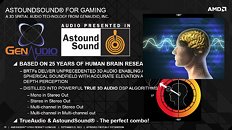Thursday, September 26th 2013

Do We Really Need AMD TrueAudio?
At its press meet called to unveil its next-generation graphics lineup, which lasted for about 3 hours and 45 minutes, a full one hour was spent detailing TrueAudio, an audio DSP that AMD co-developed with GenAudio, makers of AstoundSound technology; both of which are brand names we'd heard for the first time, and that's coming from someone who's been an audiophile and follower of PC audio technology for 15 years now. Here are a few reasons why the concept of TrueAudio, or at least the way AMD and its newfound GenAudio pals explained it, is unconvincing to the extant of flagging "snake oil." While we did not attend GPU'14, experiencing TrueAudio is irrelevant to our analysis. It focuses on what "yet another" positional audio DSP has to do with GPU, and how AMD is getting ahead of itself with non-graphics features in exactly the same way it criticized NVIDIA of doing, not too long ago.Back in the 1990s and the first half of the previous decade, discrete sound cards were an integral component of any self-respecting gaming PC, as onboard audio solutions were either too basic (ISA-based CODECs, USB-based AC'97) or sounded like greeting cards. Apart from higher fidelity, discrete sound cards offered proprietary positional-audio and DSP layers, promised hundreds of hardware-mixed audio voices, and what have you. AMD, in its presentation, didn't succeed in explaining how its solution is any different from something Dolby, Yamaha, Creative, ESS, and others haven't already tried.
With Intel's Azalia specification, and acceptable increments in audio fidelity past the 85 dBA signal-to-noise ratio mark with most motherboard-integrated audio solutions, game engine developers spent the better part of last decade innovating positional- and immersive- audio technologies that didn't require specialized hardware. You get the same incredible sound-effects on Battlefield 3 on any hardware, with discrete sound cards only offering better audio quality, but not better effects (positional- or realism). In that respect, we feel that it's quite arrogant of AMD to claim that there has been no innovation in PC game audio since programmable shaders (2001-02). To the contrary, game engine developers like Unreal, CryTek, DICE, etc., worked tirelessly to make effects comparable to three-figure discrete sound cards accessible to all gamers, by leveraging multi-core/multi-threaded CPUs.
What AMD didn't explain to us, is whether use of TrueAudio technology requires Radeon graphics cards to be installed; because if it does, then there's little difference between AMD's approach to positional-audio, and discrete sound card manufacturers', which unsuccessfully tried to make people to buy their sound cards on the "better audio immersion" plank, before switching over to the "better audio quality" plank, upon realizing that "better immersion" doesn't sell sound cards anymore.
What AMD also didn't explain is where "Radeon" fits into all this. It's a GPU alright, and combined with OpenCL, it's capable of general-purpose computing. It didn't explain whether the TrueAudio DSP layer runs on the CPU, or is something the GPU spares some of its computing power on. We're not convinced by the "hear more voices in a game" claim. The way audio is implemented on Windows, an application can stream up to 65,535 "voices" (independent streams of digital audio through a software/inter-process-communication channel), which are then mixed into "what you hear." So the only way AMD can sell "hear more voices," is if it gives developers something that can let them stream those hundreds of voices, while minimizing the CPU cost of processing and mixing them. If not having those many voices in any way steps beyond being just aesthetics (think crowds in a games like Assassins Creed, GTA), and actually affects the gameplay (i.e. not hearing all those voices puts you at a disadvantage in, say, an online multiplayer shooter), then you can bet your bottom penny that developers won't implement it.
In conclusion, even if TrueAudio made genuine improvements in the accuracy of positional audio, which they claim is backed by "25 years of brain research," there are too many factors stacked up against its successful proliferation. Want better sound? Go get a nice sound card and/or better speakers/headsets. Don't count on dinosaur DSPs anymore. There are two components to better game audio, "immersion" and "output quality." Your game developer already took care of the "immersion" part, and today's premium sound cards and speakers/headsets look after "output quality." Not much room for AMD to squeeze into this neat little arrangement.
With Intel's Azalia specification, and acceptable increments in audio fidelity past the 85 dBA signal-to-noise ratio mark with most motherboard-integrated audio solutions, game engine developers spent the better part of last decade innovating positional- and immersive- audio technologies that didn't require specialized hardware. You get the same incredible sound-effects on Battlefield 3 on any hardware, with discrete sound cards only offering better audio quality, but not better effects (positional- or realism). In that respect, we feel that it's quite arrogant of AMD to claim that there has been no innovation in PC game audio since programmable shaders (2001-02). To the contrary, game engine developers like Unreal, CryTek, DICE, etc., worked tirelessly to make effects comparable to three-figure discrete sound cards accessible to all gamers, by leveraging multi-core/multi-threaded CPUs.
What AMD didn't explain to us, is whether use of TrueAudio technology requires Radeon graphics cards to be installed; because if it does, then there's little difference between AMD's approach to positional-audio, and discrete sound card manufacturers', which unsuccessfully tried to make people to buy their sound cards on the "better audio immersion" plank, before switching over to the "better audio quality" plank, upon realizing that "better immersion" doesn't sell sound cards anymore.
What AMD also didn't explain is where "Radeon" fits into all this. It's a GPU alright, and combined with OpenCL, it's capable of general-purpose computing. It didn't explain whether the TrueAudio DSP layer runs on the CPU, or is something the GPU spares some of its computing power on. We're not convinced by the "hear more voices in a game" claim. The way audio is implemented on Windows, an application can stream up to 65,535 "voices" (independent streams of digital audio through a software/inter-process-communication channel), which are then mixed into "what you hear." So the only way AMD can sell "hear more voices," is if it gives developers something that can let them stream those hundreds of voices, while minimizing the CPU cost of processing and mixing them. If not having those many voices in any way steps beyond being just aesthetics (think crowds in a games like Assassins Creed, GTA), and actually affects the gameplay (i.e. not hearing all those voices puts you at a disadvantage in, say, an online multiplayer shooter), then you can bet your bottom penny that developers won't implement it.
In conclusion, even if TrueAudio made genuine improvements in the accuracy of positional audio, which they claim is backed by "25 years of brain research," there are too many factors stacked up against its successful proliferation. Want better sound? Go get a nice sound card and/or better speakers/headsets. Don't count on dinosaur DSPs anymore. There are two components to better game audio, "immersion" and "output quality." Your game developer already took care of the "immersion" part, and today's premium sound cards and speakers/headsets look after "output quality." Not much room for AMD to squeeze into this neat little arrangement.



87 Comments on Do We Really Need AMD TrueAudio?
Heard people at CES trying it out w/ the Occulus Rift... and pretty much losing touch with reality... Now that's some good stuff right there.
I'm pretty sure that if AMD was talking about TrueAudio technology while they were talking about their Radeon series graphics cards, they were telling you that it was coming with it. Of course it's been months since this article was written; anyone can hop down to a local computer shop or electronics store and pick up a R series video card with AMD's TrueAudio onboard now, and it's been known that some Radeon HD 7000 series cards actually also had TrueAudio (And Mantle) but the feature was not yet enabled. AMD has CLEARLY been working on it's solutions for a significant amount of time and hasn't exactly made a secret about it. I don't know why the author of this article repeatedly implies that AMD is coming out of nowhere with something "half baked" or immature.
It's true that programmers worked tirelessly on Unreal and Crytek to program the heck out of the integrated audio solutions in most motherboards. AMD is asking a single question; WHY make the CPU do all that work especially when the technology as this author has pointed out, has been around a while? The reality is that the CPU can use more than 10% of it's processing power working up positional audio for your speaker system especially when working with an onboard Realtek solution for example. Your CPU does not need to be burdened with this; not when the technology to off-load this has been available for years. It makes you wonder how Realtek has managed to survive all this time, and if AMD makes it's next leap with TrueAudio and integrates it into A series APU's for Desktop / Mobile (and consoles) then Realtek, VIA, and SiS are probably going to be knocked out of the integrated audio market unless they come up with audio processors instead of codecs because someone else came up with something better. Intel will like usual see AMD has done something impressive and move to copy it / enhance it / outperform it.
Oh and as for the "hearing more voices claim" while it's true Windows allows many voices, for years discreet audio has hung around up to 64 voices because of hardware limitations. Discreet cards and integrated solutions have not had the horsepower to deliver as many voices as Windows can support, and SNR also determines whether or not the signal is "clean" enough that the number of voices don't get muddled together. I have not been able to find out what AMD's SNR is on their TrueAudio solution but if it has the horsepower and clarity to do around 150 voices obviously they have done some serious work on the quality of their audio output. Let's not forget that since their solution is reliant on HDMI that it is a 100% digital signal, and not an analog solution. This is a huge difference between AMD's solution and traditional analog audio.
In conclusion, this article was written by a guy who didn't have a clue what he was talking about. Even at the time this article was written, there was plenty of information about AMD TrueAudio being released. He just didn't research it, assuming he knew all he needed from a single presentation. Then he condemned it as pointless. As for me, I was until recently using a USB Sound Blaster X-Fi for my audio. When I decided to give TrueAudio a try, I connected my Klipsch 2.1 THX Promedia speakers into my flat panel and see what AMD had come up with. Rest assured, if I can hear a noticeable improvement in clarity between a very current $100 Creative Labs X-Fi and the FREE AMD TrueAudio bundled with my new Radeon R7 260x, I don't know how Creative Labs or Realtek are going to stay in business.
www.maximumpc.com/everything_you_wanted_know_about_amd%E2%80%99s_new_trueaudio_technology_2013
For example, author stated:
"there are too many factors stacked up against its successful proliferation. Want better sound? Go get a nice sound card and/or better speakers/headsets."
The interview above AMD said already True Audio does not get in the way of sound cards, one can use sound card's high quality Op amp and DAC and leave True Audio to do the computation, and this is all seamless because the GPU has all the positional information, and audio is intercepted well before the Windows audio stack.
said the dead thread.....
I have always been able to get my 5.1 sound to if the game supports 5.1 unlike a lot of add in cards having one issue or another with clipping and lockups due to sound.
So say all you like and it's not if i would trust a ad magazine anyways which holds about 4% of any thing what you would want to read.hehe
So over 1 year later, 4 games support TrueAudio, 3 of them suck and are a commercial disaster, the 4th is yet unreleased.